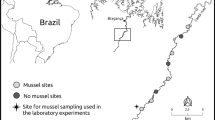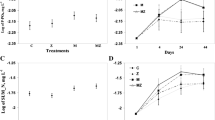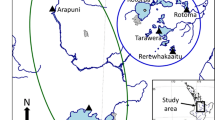Abstract
Zebra mussels (Dreissena polymorpha) graze on phytoplankton, and decreased phytoplankton concentrations have been associated with zebra mussels in lakes. It is not known, however, how the zebra mussel will affect phytoplankton in turbid systems such as rivers and the freshwater portions of estuaries. To determine whether zebra mussels can effectively remove phytoplankton in these turbid systems, and to determine what components of the suspended material are removed and at what rates, we conducted a series of grazing and size-selection experiments using ambient Hudson River water and its natural phytoplankton community. Zebra mussels removed both phytoplankton and total suspended weight (TSW) at comparable rates (∼115 ml mussel−1 h−1). Variation in filtration rates were not correlated with TSW or chlorophylla (chla) concentration, and did not appear to depend on relative proportions of either component. Mussels removed particles with approximately equal efficiency in all particle size classes measured (0.4 μm to >40 μm). Zebra mussels appear to remove Hudson River phytoplankton effectively in the presence of suspended sediment and do so at rapid rates. Based on our measurements and unpublished estimates of the size of the population, zebra mussels filter a volume equivalent to the entire volume of the tidal freshwater portion of the Hudson River about every 2 d.
Similar content being viewed by others
Literature Cited
Alexander, J. E., Jr.,J. H. Thorp, andR. D. Fell. 1994. Turbidity and temperature effects on oxygen consumption in zebra mussels (Dreissena polymorpha).Canadian Journal of Fisheries and Aquatic Sciences 51:179–184.
Caraco, N. F., J. J. Cole, P. A. Raymond, D. L. Strayer, M. L. Pace, S. E. G. Findlay, and D. T. Fischer. In press. Zebra mussel invasion in a large turbid river: Phytoplankton response to increased grazing.Ecology
Cole, J. J., N. F. Caraco, andB. L. Peierls. 1992. Can phytoplankton maintain a positive carbon balance in a turbid, freshwater tidal estuary?Limnology and Oceanography 37:1608–1617.
Feldman, D. S., Jr.,J. Gagnon, R. Hofmann, andJ. Simpson. 1987. StatView II: The Solution for Data Analysis and Presentation Graphics. Abacus Concepts, Inc., Berkeley, California.
Frechette, M. andE. Bourget. 1985. Energy flow between the pelagic and benthic zones: Factors controlling particulate organic matter available to an intertidal mussel bed.Canadian Journal of Fisheries and Aquatic Sciences 42:1158–1165.
Frechette, M., C. A. Butman, andW. R. Geyer. 1989. The importance of boundary-layer flows in supplying phytoplankton to the benthic suspension feeder,Mytilus edulis L.Limnology and Oceanography 34:19–36.
Hobbie, J. R., R. J. Daley, andS. Jasper. 1977. Use of nuclepore filters for counting bacteria by fluorescence microscopy.Applied and Environmental Microbiology 22:1225–1228.
Holland, H. E. 1993. Changes in planktonic diatoms and water transparency in Hatchery Bay, Bass Island area, western Lake Erie since the establishment of the Zebra Mussel.Journal of Great Lakes Research 19:617–624.
Holm-Hansen, O. andB. Riemann. 1978. Chlorophyll a determination: Improvements in methodology.Oikos 30:438–447.
Jorgensen, C. B., T. Kiorboe, F. Mohlenberg, andH. U. Riisg»rd. 1984. Ciliary and mucus-net filter feeding, with special reference to fluid mechanical characteristics.Marine Ecology-Progress Series 15:283–292.
Koch, A. L. 1981. Growth measurement, p. 179–207.In P. Gerhardt (ed.), Manual of Methods for General Bacteriology. American Society for Microbiology, Washington, D.C.
Kryger, J. andH. U. Riisgård. 1988. Filtration rate capacities in 6 species of European freshwater bivalves.Oecologia 77:34–38.
MacIssac, H. J., W. G. Sprules, O. E. Johnnsson, andJ. H. Leach. 1992. Filtering impacts of larval and sessile zebra mussels (Dreissena polymorpha) in western Lake Erie.Oecologia 92:30–39.
Mackie, G. I., W. N. Gibbons, B. W. Muncaster, andI. M. Gray. 1989. The Zebra Mussel,Dreissena Polymorpha: A Synthesis of European Experiences and a Preview for North America. Queen’s Printer for Ontario, Ontario, Canada.
Mills, E. L., D. L. Strayer, M. D. Scheuerell, and J. T. Carlton. 1996. Exotic species in the Hudson River basin: A history of invasions and introductionsEstuaries 19:xxx–xxx.
Nichools, S. J. 1993. Maintenance of the zebra mussel (Dreissena polymorpha) under laboratory conditions, p. 733–747.In T. F. Nalepa and D. W. Schloesser (eds.), Zebra Mussels: Biology, Impacts, and Control. Lewis Publishers, Ann Arbor, Michigan.
O’Riordan, C. A., S. G. Monismith, andJ. R. Koseff. 1993. A study of concentration boundary-layer formation over a bed of model bivalves.Limnology and Oceanography 38:1712–1729.
Reeders, H. H., A. Bij de Vaate, andR. Noordhuis. 1993. Potential of the zebra mussel (Dreissena polymorpha) for water quality management, p. 439–451.In T. F. Nalepa and D. W. Schloesser (eds.), Zebra Mussels: Biology, Impacts, and Control. Lewis Publishers, Ann Arbor, Michigan.
Reeders, H. H., A. Bij de Vaate, andF. J. Slim. 1989. The filtration rate ofDreissena Polymorpha (Bivalvia) in three Dutch lakes with reference to biological water quality management.Freshwater Biology 22:133–141.
Sprung, M. andU. Rose. 1988. Influence of food size and food quantity on the feeding of the musselDreissena polymorpha.Oecologia 77:526–532.
Sprung, M. andU. Rose. 1989. Field and laboratory observation ofDreissena polymorpha larvae: Abundance, growth, mortality, and food demands.Archiv fur Hydrobiologie 115:537–561.
Stanczykowska, A. andK. Lewandowski. 1993. Thirty years of studies ofDreissena polymorpha ecology in Mazurian Lakes of northeastern Poland. p. 3–37.In T. F. Nalepa and D. W. Schloesser (eds.), Zebra Mussels: Biology, Impacts, and Control. Lewis Publishers, Ann Arbor, Michigan.
Strayer, D. L. 1991. Projected distribution of the zebra mussel,Dreissena polymorpha, in North America.Canadian Journal of Fisheries and Aquatic Science. 48:1389–1395.
Strayer, D. L. andL. C. Smith. 1993. Distribution of the zebra mussel (Dreissena polymorpha) in estuaries and brackish waters, p. 715–727.In T. F. Nalepa and D. W. Schloesser (eds.), Zebra Mussels: Biology, Impacts, and Control. Lewis Publishers, Ann Arbor, Michigan.
Stross, R. G. andR. C. Sokol. 1989. Runoff and flocculation modify underwater light environment of the Hudson River estuary.Estuarine, Coastal and Shelf Science 29:305–316.
Wisniewski, R. 1990. Shoals ofDreissena polymorpha as bio-processor of seston.Hydrobiologia 200/201:451–458.
Author information
Authors and Affiliations
Rights and permissions
About this article
Cite this article
Roditi, H.A., Caraco, N.F., Cole, J.J. et al. Filtration of Hudson River water by the zebra mussel (Dreissena polymorpha). Estuaries 19, 824–832 (1996). https://doi.org/10.2307/1352300
Received:
Accepted:
Issue Date:
DOI: https://doi.org/10.2307/1352300




